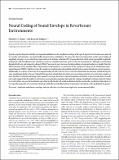| dc.contributor.author | Slama, Michael C. C. | |
| dc.contributor.author | Delgutte, Bertrand | |
| dc.date.accessioned | 2015-09-08T17:45:07Z | |
| dc.date.available | 2015-09-08T17:45:07Z | |
| dc.date.issued | 2015-03 | |
| dc.date.submitted | 2015-01 | |
| dc.identifier.issn | 0270-6474 | |
| dc.identifier.issn | 1529-2401 | |
| dc.identifier.uri | http://hdl.handle.net/1721.1/98403 | |
| dc.description.abstract | Speech reception depends critically on temporal modulations in the amplitude envelope of the speech signal. Reverberation encountered in everyday environments can substantially attenuate these modulations. To assess the effect of reverberation on the neural coding of amplitude envelope, we recorded from single units in the inferior colliculus (IC) of unanesthetized rabbit using sinusoidally amplitude modulated (AM) broadband noise stimuli presented in simulated anechoic and reverberant environments. Although reverberation degraded both rate and temporal coding of AM in IC neurons, in most neurons, the degradation in temporal coding was smaller than the AM attenuation in the stimulus. This compensation could largely be accounted for by the compressive shape of the modulation input–output function (MIOF), which describes the nonlinear transformation of modulation depth from acoustic stimuli into neural responses. Additionally, in a subset of neurons, the temporal coding of AM was better for reverberant stimuli than for anechoic stimuli having the same modulation depth at the ear. Using hybrid anechoic stimuli that selectively possess certain properties of reverberant sounds, we show that this reverberant advantage is not caused by envelope distortion, static interaural decorrelation, or spectral coloration. Overall, our results suggest that the auditory system may possess dual mechanisms that make the coding of amplitude envelope relatively robust in reverberation: one general mechanism operating for all stimuli with small modulation depths, and another mechanism dependent on very specific properties of reverberant stimuli, possibly the periodic fluctuations in interaural correlation at the modulation frequency. | en_US |
| dc.description.sponsorship | National Institutes of Health (U.S.) (Grant R01DC002258) | en_US |
| dc.description.sponsorship | National Institutes of Health (U.S.) (Grant P30DC0005209) | en_US |
| dc.description.sponsorship | Paul and Daisy Soros Fellowships for New Americans | en_US |
| dc.language.iso | en_US | |
| dc.publisher | Society for Neuroscience | en_US |
| dc.relation.isversionof | http://dx.doi.org/10.1523/jneurosci.3615-14.2015 | en_US |
| dc.rights | Creative Commons Attribution | en_US |
| dc.rights.uri | http://creativecommons.org/licenses/by/4.0/ | en_US |
| dc.source | Society for Neuroscience | en_US |
| dc.title | Neural Coding of Sound Envelope in Reverberant Environments | en_US |
| dc.type | Article | en_US |
| dc.identifier.citation | Slama, M. C. C., and B. Delgutte. “Neural Coding of Sound Envelope in Reverberant Environments.” Journal of Neuroscience 35, no. 10 (March 11, 2015): 4452–68. | en_US |
| dc.contributor.department | Massachusetts Institute of Technology. Research Laboratory of Electronics | en_US |
| dc.contributor.department | Massachusetts Institute of Technology. Speech and Hearing Biosciences and Technology Program | en_US |
| dc.contributor.mitauthor | Slama, Michael C. C. | en_US |
| dc.contributor.mitauthor | Delgutte, Bertrand | en_US |
| dc.relation.journal | Journal of Neuroscience | en_US |
| dc.eprint.version | Final published version | en_US |
| dc.type.uri | http://purl.org/eprint/type/JournalArticle | en_US |
| eprint.status | http://purl.org/eprint/status/PeerReviewed | en_US |
| dspace.orderedauthors | Slama, M. C. C.; Delgutte, B. | en_US |
| dc.identifier.orcid | https://orcid.org/0000-0003-1349-9608 | |
| mit.license | PUBLISHER_CC | en_US |
| mit.metadata.status | Complete | |
